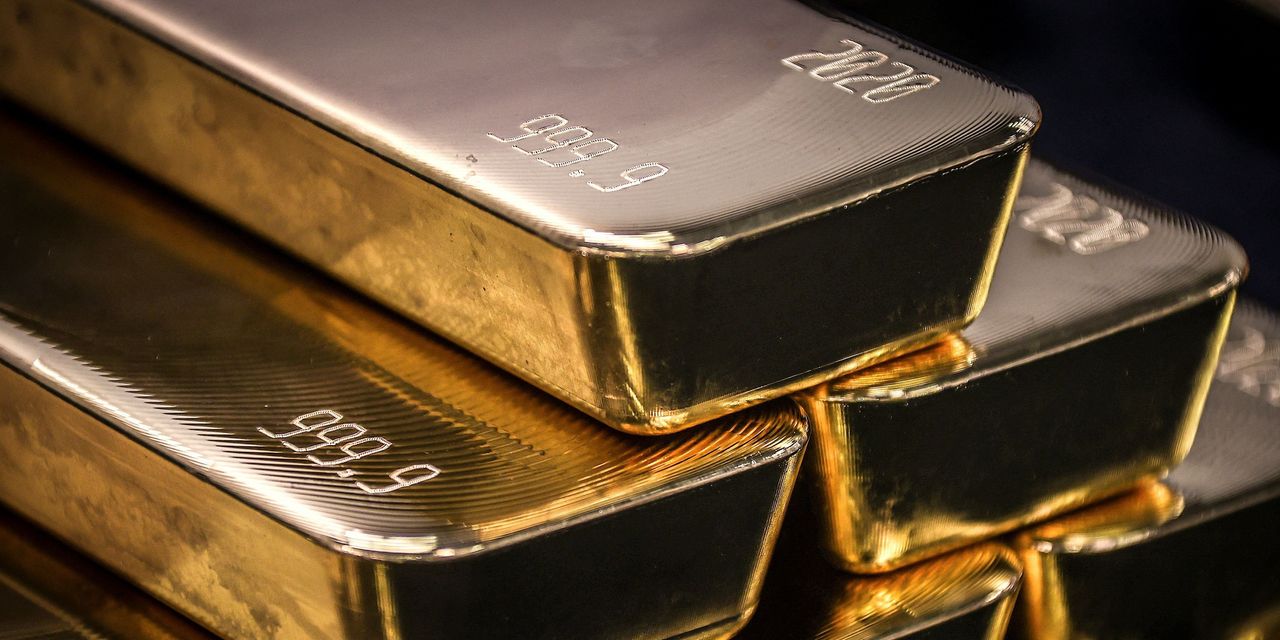Gold futures climbed on Friday, after a report on U.S. consumer sentiment showed that inflation has slowed, but prices were poised to end the week with a more than 2% loss, a day after settling at their lowest in over two years.
Price action
-
Gold for December delivery
GC00,
+0.30% GCZ22,
+0.30%
was up $10, or 0.6%, at $1,687.30 an ounce on Comex, on track for a weekly decline of 2.4%. -
December silver
SIZ22,
+0.47%
added 23.1 cents, or 1.2%, to $19.50 an ounce, trading 4% higher for the week. -
In other metals trade, October platinum
PLV22,
-0.27%
fell 0.7% to $896.90 an ounce, while December palladium
PAZ22,
-1.82%
shed 1.5% to $2,115 an ounce. -
December copper
HGV22,
+0.47%
was up 0.7% at $3.515 a pound.
Market drivers
Gold has been under pressure this week, though looked to pare some of those losses on Friday, after a hotter-than-expected reading of the U.S. August consumer-price index reinforced expectations the Federal Reserve will raise its fed-funds rate by at least another 75 basis points when it meets next week.
“The monetary tightening represents a cloud over gold that has begun to weigh on prices, having fallen somewhat steadily since April of this year, despite ongoing risk,” said Christopher Louney, analyst at RBC Capital Markets, in a note.
“It seems that this is largely the story that will play out over the course of H2 2022, given rising rates and a strong dollar,” he wrote. “In fact, while our high scenario is not written off, it would clearly take a big risk off event to change the tide. The fact that gold has not really performed incrementally well even when equities have sold off recently (rolling correlation has even risen) tells us that the perceived haven role is not driving gold at the moment.”
While gold is often described as an inflation hedge, the aggressive tightening by the Fed has served to send the U.S. dollar surging versus major rivals, with a dollar index
DXY,
trading near a 20-year high, while Treasury yields have jumped.
A stronger dollar is seen as a negative for commodities priced in the unit, making them more expensive to users of other currencies. Higher bond yields are also a headwind, raising the opportunity cost of holding nonyielding assets.
Gold prices on Friday, however, moved higher shortly after a report from the University of Michigan showed that U.S. consumer sentiment rose to 59.5 in September and hit a five-month high. It also revealed that inflation has slowed a bit in the past few months.
Combined with Thursday’s poor U.S. retail sales data, the consumer sentiment “makes a full 1 percent hike from the Fed next week far less likely than the futures market thinks,” Adrian Ash, director of research at BullionVault, told MarketWatch. “It says that any feelgood factor from the solid labor market is being overwhelmed by inflation, rising borrowing costs, and deep uncertainty about the economy.”
‘Shades’ of the 2013 gold crash
On Thursday, gold futures fell 1.9% to settle at $1,677.30, their lowest finish since April 2020 and biggest one-day percentage loss since July 5.
Ash said he saw “shades of the 2013 gold crash” in this week’s drop. Nine years ago, gold “tested its post-financial crisis floor of $1,535 four times before cracking lower,” leading to a 15% two-day plunge in spot prices, with the metal losing 25% inside three months and posting its worst annual loss since 1981, he said.
Gold’s outlook now rests on four key differences between the spring of 2013 and fall of 2022, said Ash.
The technical break in prices has only come in terms of the soaring U.S. dollar and gold’s drop to two-year lows isn’t yet carrying through to other precious metals, he said. Also, gold’s fall through its $1,680 floor coincides with heaving selling across other asset classes, which is likely to add safe-haven demand for gold, and rising rate expectations threaten to worsen the economic slowdown, he said.
“Gold may very well struggle to rally for as long as the Fed says that fighting inflation remains its No.1 concern,” said Ash. “The flip, when it comes, could see a swift and sharp bounce-back, and a rush for the exits like 2013 looks highly unlikely.”
